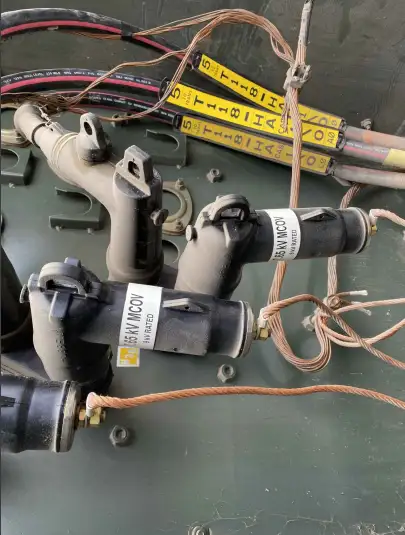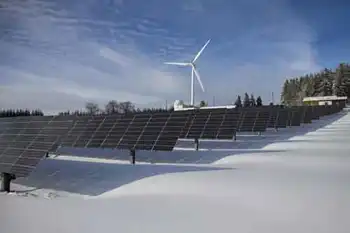CoalÂ’s future wagered on carbon capture
By Washington Post
Protective Relay Training - Basic
Our customized live online or in‑person group training can be delivered to your staff at your location.

- Live Online
- 12 hours Instructor-led
- Group Training Available
The device is being housed in a building four stories tall and bigger than a football field. A 150-foot-tall exhaust stack — so wide that it would take six adults with their arms fully stretched to reach around it — will reach into the sky. And pipelines will run out of the building and into saline aquifers two miles underground. The entire contraption will start up as early as September.
The purpose: capturing carbon dioxide emissions and stashing them in underground rock formations — a critical part of the global effort to slow climate change. This is the technique that promoters say will make coal "clean" and critics say is an expensive pipe dream.
The stimulus bill devoted $2.4 billion to pilot projects. The Obama administration awarded $20 million of that to a program that uses supersonic shockwaves to compress carbon for storage, on top of $408 million in stimulus money awarded to two other carbon pilot projects. It has pledged $1 billion more to a model plant called FutureGen. If the Waxman-Markey climate bill becomes law, a new Carbon Storage Research Corp. would pump another $1.1 billion a year into researching this nascent technology, and first movers would get billions of dollars more in bonus emission allowances that could be sold.
Coal companies and environmentalists alike are counting on a breakthrough in carbon capture and storage technology to siphon off harmful emissions from the world's coal plants. Coal plants in the United States account for a third of U.S. greenhouse emissions. In the past five years China has brought online coal-fired electricity equal in size to total U.S. installed capacity, and new plants are coming online in the developing world all the time. Without a breakthrough on coal plants, it may be impossible to meet emission limits climatologists say are needed.
Yet carbon capture and storage remains the elusive holy grail of the coal industry, an idea that could contain the damage inflicted by coal-burning power plants but a technology that remains expensive, energy intensive and largely untested. Even optimists say it will not be commercially available for another six to 10 years. Pessimists say it might take much longer, and may never be ready for widespread use without attaching a punishingly high price to carbon.
"There is no credible pathway towards prudent greenhouse gas stabilization targets without CO2 emissions reduction from existing coal power plants," Ernest Moniz, a professor at the Massachusetts Institute of Technology and a member of President Obama's Council of Advisers on Science and Technology, said in a report earlier this year. "We urgently need technology options for these plants and policies that incentivize implementation."
Coal "is still the elephant in the room," said John Ashton, special representative for climate change at Britain's Foreign and Commonwealth Office, at a meeting in Washington last month. "We can't deal with it, we can't tame it without... carbon capture and storage." He said that to meet the newly agreed upon target of limiting global warming to two degrees, nations must make carbon capture "standard technology by 2020."
The West Virginia plant belongs to American Electric Power, an electric utility that is the largest consumer of coal in the United States. "Clearly carbon capture and storage is essential for a company like AEP, and I would argue equally essential for the United States, because you can't go through the process of prematurely shutting down half the supply base of the American utility industry," said Michael Morris, chief executive of AEP.
But the AEP project illustrates the tremendous obstacles ahead. As big as it is, the equipment there will only capture the emissions from 20 megawatts of power generation, a meager 15 percent of the plant's output. Morris's predecessors were smart enough to buy lots of extra land at the West Virginia plant, but other coal plants would have trouble finding room.
The big capture device, built by France's Alstom, would take the exhaust of the plant after the coal is burned and "bubble" it through a solution of chilled ammonia. The CO2 will bond with the ammonia and be separated from other gases. Then the carbon dioxide will be separated from the ammonia and compressed for storage.
The huge carbon capture and storage devices are hugely expensive, too. AEP executives estimate that the cost of carbon capture for a modest-size coal plant of about 235 megawatts would start at $700 million. That works out to about $100 for a ton of carbon dioxide, far above the projections made by the Environmental Protection Agency about prices under a cap-and-trade scheme similar to one passed by the House in June. MIT put the cost of carbon capture and storage at $50 to $70 a ton. (The Waxman-Markey bill would give the first six gigawatts of plants — equal to around seven average-sized plants — a $90 per ton subsidy in the form of free allowances.)
Capture and storage devices also require large amounts of energy. The Alstom approach sucks up about 15 percent of the power plant's energy output; other processes use as much as 30 percent. That means the utility must purchase other energy sources to cover the shortfall. (The energy lost is part of the $700 million cost, AEP executives said.)
As a result, many experts say countries would be better off retrofitting old coal plants or replacing them with new, more efficient ones. Retrofits could result in emission reductions of 4 to 5 percent, MIT said in its study. More costly replacements of older plants could cut more than a quarter of their emissions.
Storage carries its own challenges. This involves pumping the carbon dioxide into the ground, a way of sweeping coal's harmful byproduct under the Earth's rug — forever. That can't be done just anywhere. Most of the Earth's rug has holes; it is too porous to keep carbon dioxide bottled up.
At the AEP plant in West Virginia, the gas will go into a saline aquifer; in other parts of the country storage can be established below geologic caps. The Obama administration has decided to provide $1 billion to fund FutureGen, a small, new coal plant in Illinois that would store 60 percent of its emissions in sandstone formations thousands of feet underground. Coal plants could also sell carbon dioxide to oil companies that use it to boost oil recovery in aging wells.
Many coal plants will have to be hooked up to new pipeline networks to carry the carbon dioxide to areas more suitable for storage. If linked to enhanced oil recovery projects, that could help cover costs. Otherwise, those lines will be an added expense.
"If carbon sequestration is to have an impact on the CO2 concentrations in the atmosphere, we will need to inject billions of tons of CO2 underground over the next 40 to 50 years and store them for very much longer," John Tombari, an executive at Schlumberger Carbon Services, said in congressional testimony. "The sheer scale of the challenge is daunting, and the industry that will need to develop to achieve this will be massive."
Varun Rai, a research fellow at Stanford University's Center for Environmental Science and Policy, says that there is a "disconnect" between "what is happening and what is needed by 2030." He said that the world will need to capture and store 1.5 billion to 2 billion tons of carbon dioxide by 2025.
How big is that? According to the International Carbon Bank and Exchange, a private service provider for carbon trading, a new VW Beetle driven about 12,000 miles a year will generate enough carbon dioxide to fill up the Washington Monument three times. The United States produces enough carbon dioxide to cover the nation's entire land mass with a layer one foot deep every year. Greenpeace, a foe of coal-fired power, says that to sequester all the emissions from coal-fired plants, the volume of CO2 would be equal to 28 million train cars a day, or a Grand Canyon every 15 days.
Legal quagmires also lurk. Someone will need to take responsibility for monitoring and maintaining storage sites that will have to last hundreds of years, said Tombari, far "beyond the likely lifespan of any corporation." And who will pay for that? If consumers pay a fee for storage, that fee will grow over time, and tomorrow's consumers might end up paying big legacy costs to make sure they contain the emissions of today's consumers. Many companies want the government to relieve them of any liability for unexpected consequences. (A naturally occurring "burp" of carbon dioxide from a Cameroon lake in 1986 killed hundreds of people.)
One of the prevailing theories about carbon capture and storage and about other climate-friendly technologies is that they will get better and cheaper over time. It is central to selling climate policies to consumers, because it permits policymakers to assert that costs will be tamed and energy prices will get only modestly higher.
"I'm prepared to bet on American ingenuity," said Sen. John F. Kerry (D-Mass.), when asked about the still dim prospects for carbon capture and storage. He said he believed that there are some "game-changing possibilities" being worked on.
Indeed, one company claims to have a technique that would bubble a power plant's emissions through seawater and then trap the carbon dioxide in cement. Other firms say they have pre-combustion strategies for extracting carbon dioxide, though they face the same challenges when it comes to storage.
A Stanford University study of carbon capture technologies warned that "the conventional wisdom that experience with technologies inevitably reduces costs does not necessarily hold." It said that it found "the opposite of the conventional wisdom to be true" for U.S. nuclear power from 1960 to 1980 and global liquefied natural gas from 1960 to 1995 — both areas with substantial government support. Indeed, it found costs increased.















